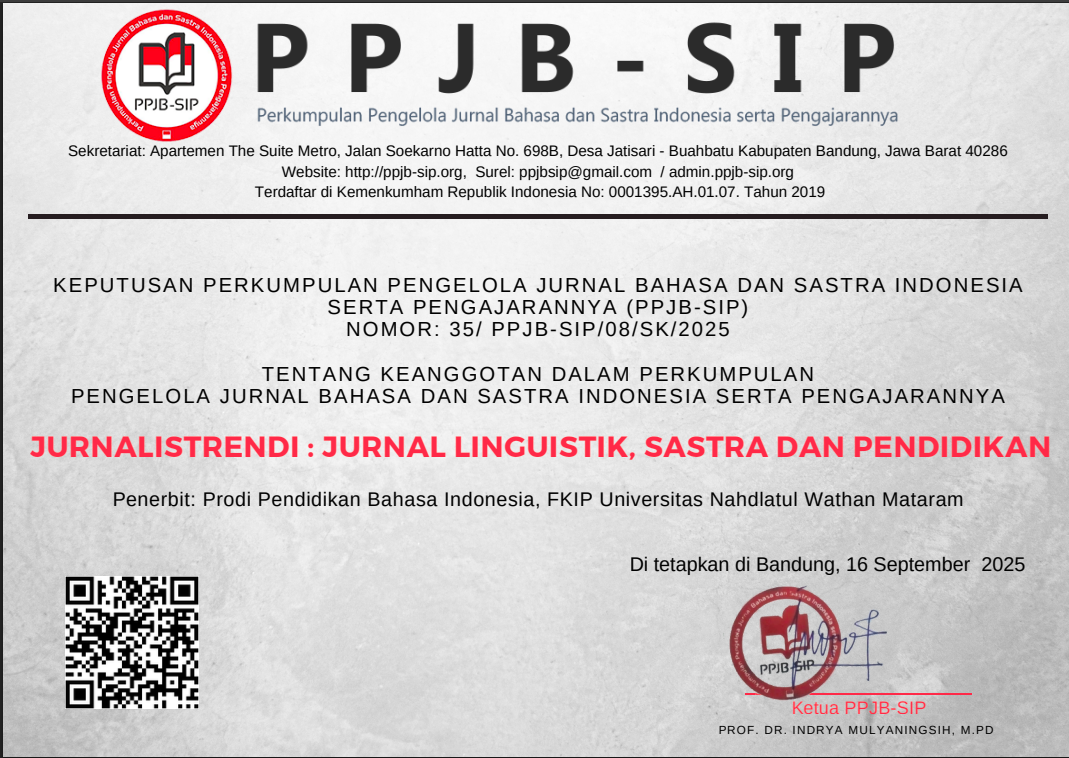Comparative Figurative Language In Justin Bieber’s Song Lyrics
Abstract
People use figurative language in order to express themselves. There are many types of figurative language, one of which is comparative figurative language. The objectives of this research are to find out the classification and the types of comparative figurative language found in Justin Bieber’s song lyrics and look for non-literal meanings in them. This research uses a qualitative method to find the types of comparative figurative language and the meaning in the song lyrics.The main data for this research were taken from the lyrics of Justin Bieber’s song containing figurative language, which focused on the classification of comparative figurative language. Since the data analysis was done by collecting, analysing, classifying the data and presenting the results of data analysis, the descriptive research approach was employed in this study. From the analysed data, this research found a total of 42 lyrics that contained comparative figurative language. Personification dominates with the highest total number of 19 (45%), followed by simile with a total number of 16 (38%), and the researcher also found metaphor with a total number of 7 (17%). There are 1 living personification, 8 non-living personifications, 10 abstract personifications, 4 open similes, 12 closed similes, 1 anthropomorphic metaphor, and 6 concrete to abstract metaphors.
Downloads
References
Alfiyani, W. (2021). Type and Meaning of the Figurative Language Found in Niki’s Selected Song Lyrics. Jurnal CULTURE (Culture, Language, and Literature Review), 8(2). https://doi.org/10.53873/culture.v8i2.271
Anita Bans Akutey. (2021). Triangulation in Research.
B.B. Nimanuho, M. S. (2019). The Analysis of Non-Literal Meaning in Christmas Carol By Charles Dickens.https://doi.org/10.21067/jibs.v4i2.3182
Benny, B., Maharani, P. D., & Nugraha Putra, I. G. B. W. (2022). The Analysis of Abstraction Personification in Skillet’s Selected Song. Jurnal Impresi Indonesia, 1(3), 184–190. https://doi.org/10.36418/jii.v1i3.25
Borghi, A. M., Flumini, A., Cimatti, F., Marocco, D., & Scorolli, C. (2011). Manipulating objects and telling words: A study on concrete and abstract words acquisition. Frontiers in Psychology, 2(FEB). https://doi.org/10.3389/fpsyg.2011.00015
Dani Nuriadin, O. (2017). Struktur Puisi Lirik Lagu Ada Band Album 2 Dekade-Terbaik dari.
Fajrin, M. Y., & Parmawati, A. (2021). An Analysis of Figurative Language Found in Song of Bruno Mars “Grenade” PROJECT (Professional Journal of English Education), 4(4). https://doi.org/10.22460/project.v4i4.p588-594
Hambali, A. M. (2020). Analisis Majas Simile dan Metafora Lirik-lirik Lagu The Beatles: Kajian Semantik. http://repository.widyatama.ac.id/xmlui/handle/123456789/11612
Hutabarat, I. (2018). Non-literal Meaning in Cosmetics Advertisement in Cosmopolitan Magazines.
Kroeger, P. R. (2022). Analyzing meaning: An introduction to semantics and pragmatics Third edition. www.github.com/langsci/359
M. Edwards, J. (2022). Semantic Studies on Song Lyrics “Be Careful on the Road” Sincere Work (Analysis of Lexical and Grammatical Meanings). OPSearch: American Journal of Open Research, 1(1). https://doi.org/10.58811/opsearch.v1i1.1
Muthalib, K. A., Apriani Fata, I., & Rohaza, V. (2021). “How Stars Stole All Night Away”: A Stylistic Aanalysis of Personification in Movie Troll’s Soundtracks.
Nduru, S. A. M. (2021). An Analysis of Magic Spells in Harry Potter and The Half-Blood Prince. Lingua Litera: Journal of English Linguistics and Literature, 6(1). https://doi.org/10.55345/stba1.v6i1.96
Priyono, G. D. (2022). Majas pada Lirik Lagu dalam Album The Essential Karya John Denver: Kajian Semantik. http://repository.widyatama.ac.id/xmlui/handle/123456789/15152
Puspitorini, F., & Hamdani, H. (2021). An Analysis of Figurative Language on The Lyrics of Coldplay’s Selected Song. International Journal of English and Applied Linguistics (IJEAL), 1(3). https://doi.org/10.47709/ijeal.v1i3.1126
Qadir, A., Riloff, E., & Walker, M. A. (2016). Automatically Inferring Implicit Properties in Similes. http://deron.meranda.us/data/census-derived-all-first.txt
Rahayu, S. B. (2018). The Use of English Song to Improve The Pronunciation Skills Among The Tenth Grade Student.
Rahmadany, S., & Husein, R. (2021). Deixis in the Song Lyrics of One Direction. KnE Social Sciences. https://doi.org/10.18502/kss.v5i4.8713
Rijal Fadli, M. (2021). Memahami desain metode penelitian kualitatif. 21(1), 33–54. https://doi.org/10.21831/hum.v21i1
Rina, N., Yanti, Y., & Hardiyanti, P. (2022). Journal of Cultura and Lingua (CULINGUA) | https Types and Functions of Metaphors in The English Quotes. https://culingua.bunghatta.ac.id/
Saeed, J. I. (2016). Semantics. www.wiley.com/wiley-blackwell.
Simatupang, E. C., & Gita Adzani, A. (2019). Syntactic and Semantic Analysis on Slogans of Aviation Companies in Asean Countries. English Journal Literacy UTama, 3(2).
Syarifah, S., Manugeren, M., & Purwarno, P. (2020). Simile Used in Lenka’s Song Everything at Once. AICLL: Annual International Conference on Language and Literature, 3(1). https://doi.org/10.30743/aicll.v3i1.77
Vega, H., Siahaan, F., & Hum, M. (2018). Figurative Language in Selected Poems. www.wikipedia.org
Vulchanova, M., Milburn, E., Vulchanov, V., & Baggio, G. (2019). Boon or Burden? The Role of Compositional Meaning in Figurative Language Processing and Acquisition. Journal of Logic, Language and Information, 28(2), 359–387. https://doi.org/10.1007/s10849-019-09282-7
Weiland, H., Bambini, V., & Schumacher, P. B. (2014). The role of literal meaning in figurative language comprehension: Evidence from masked priming ERP. Frontiers in Human Neuroscience, 8(AUG). https://doi.org/10.3389/fnhum.2014.00583
Wulandari, R., & Yosiana, M. (2022). Majas Citraan dalam Lirik Lagu Tulus dalam Album Manusia. 1(4).
Yanthi Sihombing, R., Pangaribuan, R., & Simanjuntak, H. (2015). An Analysis Of Non-Literal Meaning in Beyonce’s Selected Song Lyrics.
Yunira, S., Fradina, S., Sumbayak, M., Putri, N. S., & Derin, T. (2020). Re-Visits the Grand Theory of Geoffrey Leech: Seven Types of Meaning. REiLA : Journal of Research and Innovation in Language, 1(3). https://doi.org/10.31849/reila.v1i3.3768

.jpg)





